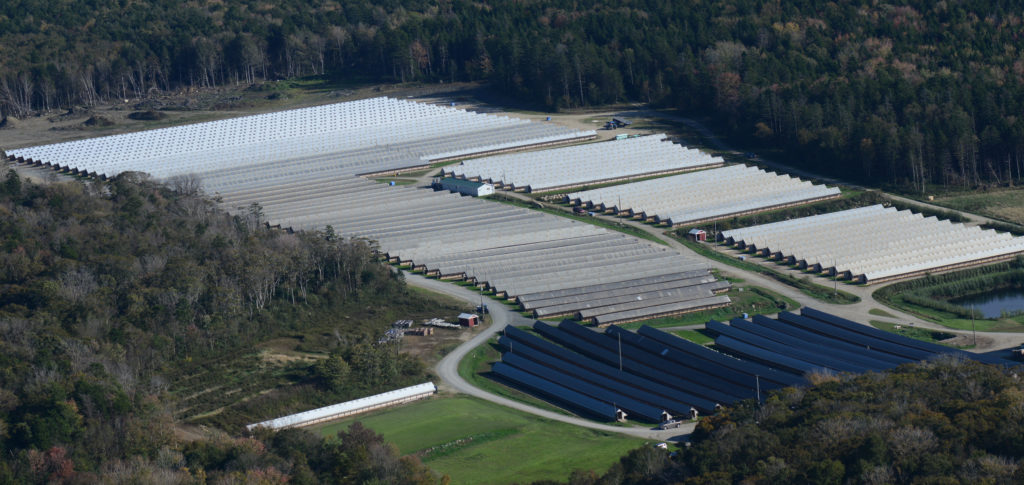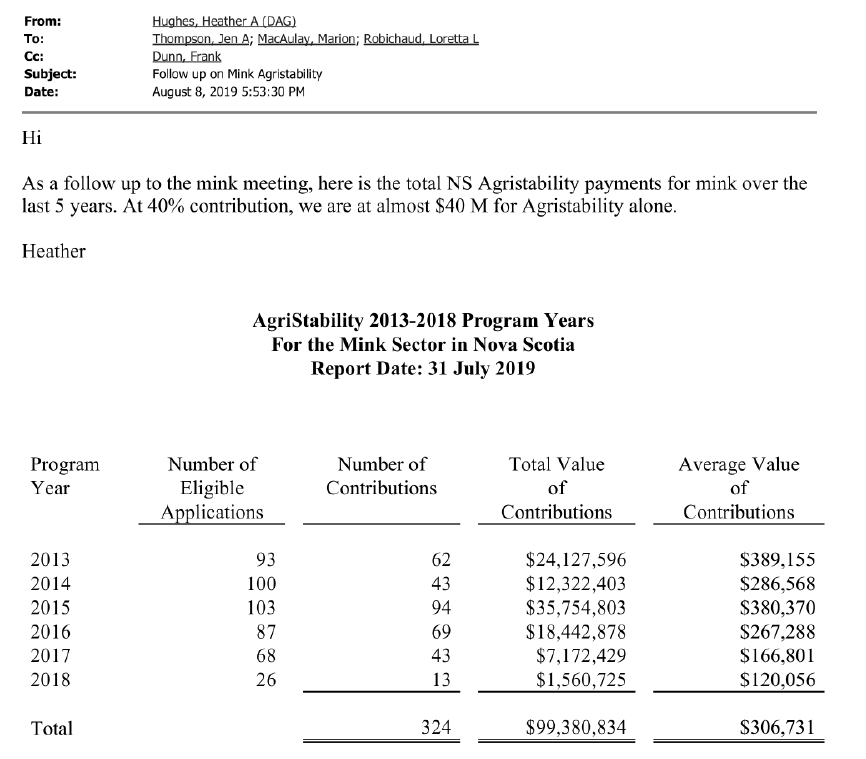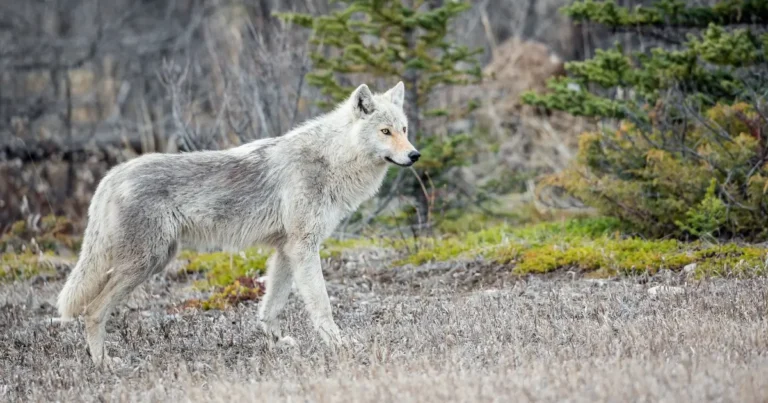
Photo by We Animals Media.
The Fur-Bearers has obtained documents showing the extent of government support for the country’s largest fur-producing province: Nova Scotia.
Between 2013-2018, mink farmers in Nova Scotia accessed $99,380,834 through AgriStability funding. AgriStability is a risk management program that is offered to agricultural producers to help protect from income declines. The costs for AgriStability are shared by the federal and provincial/territorial governments at 60% and 40%, respectively.

The Fur-Bearers requested more recent AgriStability information for 2019-2021 but the Nova Scotia Department of Agriculture did not provide information for those years. However, information was obtained regarding the province’s Mink Industry Enhancement Program (click here for our previous post on the program). Under the Mink Industry Enhancement Program, the Nova Scotia government pays mink farmers $25 for each breeding female mink. In 2021-22, $921,050 was paid to mink farmers through this program.

In an industry marked by high volatility and rapid declines, the fur farming sector would not be able to financially sustain itself if it wasn’t propped up by a host of agricultural support programs from the provincial and federal governments. Given the public health threats of mink farming seen during the COVID-19 pandemic, the cruel nature of intensively farming and confining wildlife, the environmental pollution from fur farms, and the irrelevancy and unprofitability of fur fashion products in the 21st century, the federal and provincial governments need to re-evaluate their financial supports for this outdated and cruel practice.
It’s time for all provinces and the federal government to take action on fur farming. Public funds and government programs that are being provided to fur farmers should instead be used to help them transition to sustainable and ethical industries; workers should be supported to obtain training in safer and more viable agricultural sectors. After British Columbia announced it would phase out mink farming 2021, it provided supports for mink farm workers to gain skills-training to work in the province’s greenhouse sector. British Columbia has taken leadership on fur farming, now other provinces and the federal government need to follow suit.
Nova Scotia mink farms - new research!
New research has been published this year about Nova Scotia’s mink farms. We provided a research summary in a previous post here. The following articles published in 2022 address the impacts of mink farming in Nova Scotia.
Abstract
Nova Scotia produces more mink pelts than any other province, but its fur farming industry imposes costs disproportionate to its benefits. These costs include the substantial financial aid given to mink farms, the toxic algae blooms in some lakes, the frequent spread of viruses from mink to humans and wildlife, the regular and wasteful mass culls of diseased mink, and the animal suffering caused by captivity, neglect, and abuse. Federal and provincial legislation does not and cannot provide meaningful protection to mink because of innate species characteristics and the cruelties inherent in the fur industry. Due to the association between mink farming and the spread of COVID-19, British Columbia plans to prohibit the practice; Nova Scotia should do the same.
Sarah Frame, “Sinking Mink: An Argument for Ending the Mink Industry in Nova Scotia” (2022) 45:1 Dal LJ 109.
Link to article: https://digitalcommons.schulichlaw.dal.ca/cgi/viewcontent.cgi?article=2187&context=dlj
Abstract
Farming of carnivorous animals for pelts potentially contaminates nearby ecosystems because animal feed and waste may contain persistent organic pollutants (POPs) and metals. Mink farms in Nova Scotia (NS), Canada, provide mink with feed partially composed of marine fish meal. To test whether mink farms potentially contribute contaminants to nearby lakes, we quantified organochlorine pesticides (OCP), polychlorinated biphenyls (PCB), and total mercury (THg) in mink/aquaculture feed, waste, and sediment collected from 14 lakes within rural southwest NS where mink farms are abundant and have operated for decades. Mercury, PCBs, dichlorodiphenyltrichloroethane (DDT), hexachlorocyclohexane (HCH), and dieldrin were present in mink/aquaculture feed and mink waste, indicating they are potential contaminant sources. Lakes with mink farms in their catchment exhibited significantly higher THgflux than lakes downstream of mink farming activity and reference lakes (p < 0.0001) after the intensification of mink farming in 1980, indicating mink farming activity is likely associated with increased lacustrine THgflux. Sedimentary ƩPCBflux was elevated in lakes with mink farms in their catchments, suggesting possible PCB contributions from mink farming, local agriculture, and atmospheric deposition. Elevated ƩDDT in lakes near mink farms relative to reference lakes suggests a possible enrichment related to mink farming, although mixed land use and historical DDT usage related to forestry in the region complicates DDT source attribution. Maximum dieldrinflux and HCHflux in lake sediment occurred coeval with peak worldwide usage in the 1970s and are unlikely to be associated with local mink farming. Lakes with mink farming activities in their catchments were associated with increased THgflux, ƩPCBflux, and possibly ƩDDTflux, suggesting a possible
Gregory, B.R.B., Kissinger, J.A., Clarkson, C., Kimpe, L.E., Eickmeyer, D.C., Kurek, J., Smol, J.P., and Blais, J.M. 2022. Are fur farms a potential source of persistent organic pollutants or mercury to freshwater ecosystems? Science of the Total Environment 833: 155100.
Link to article: http://dx.doi.org/10.1016/j.scitotenv.2022.155100
Abstract
Mink fur farming was once a widespread agricultural activity in southwestern Nova Scotia. Freshwaters near to and downstream of several mink fur farm operations have experienced severe water quality issues, including eutrophication and recurring algal blooms. Here, we use dated lake sediments to examine trends in primary producers and primary consumers from a hypereutrophic lake to assess how cladoceran assemblages have responded to extreme eutrophication. Shifts in the dominant pelagic cladoceran taxa began in the early 1900s, coinciding with an increase in sedimentary chlorophyll-a concentrations. Notably, small-bodied bosminids decreased, while taxa such as Chydorus brevilabris and Daphnia pulex spp. dominated assemblages in recent decades. Bottom-up ecological factors, such as decades of greater primary production, were the likely drivers of assemblage shifts of primary consumers. Consistent body sizes of bosminids throughout the sedimentary record suggested that pelagic cladocerans were not influenced solely by predation pressure from macroinvertebrates or fish. This study provides evidence of large-scale ecological shifts occurring at multiple trophic levels in a hypereutrophic temperate lake with mink farming operations in its catchment.
Jones, A., Labaj, A., Campbell, J., Libera, N., and Kurek, J. 2022. Zooplankton assemblage and body size responses to severe lake eutrophication from agricultural activities near mink farms in Nova Scotia, Canada. Journal of Plankton Research.
Link to article: doi.org/10.1093/plankt/fbac022
Abstract
Mink fur farms in southwestern Nova Scotia, Canada, are a suspected source of nutrients that have likely contributed to water quality issues in nearby lakes. Despite a decade of water quality monitoring, the cumulative effects of mink farming are not fully known due to a lack of information regarding baseline conditions. We used sedimentary midge remains and visible reflectance spectroscopy of sedimentary chlorophyll a (VRS Chl-a) to assess environmental changes prior to and following the establishment and growth of the local mink farming industry. Study lakes include hypereutrophic Nowlans Lake, with mink farms near its shoreline, mesotrophic Porcupine Lake with mink farms upstream, and oligotrophic Clearwater Lake (reference lake) with no mink farms in the catchment. We recorded a significant compositional shift in midge assemblages at Nowlans Lake (ANOSIM: 0.63, P < 0.001) following an increase in VRS Chl-a and the growth of the industry ca. 1970. Midge assemblage changes were indicative of a deterioration of benthic habitat and included increases in taxa associated with productive environments (i.e., Glyptotendipes, Endochironomus, and Cricotopus). Porcupine and Clearwater lakes, however, showed no significant assemblage shifts, suggesting relatively stable benthic conditions. VRS Chl-a increased around the 1950s in Porcupine Lake, whereas VRS Chl-a in Clearwater Lake increased around the 1980s. Our findings indicate that impacts from mink farming should be considered from a site-specific context. This study highlights the complexity of shallow lake responses associated with human activities related to >50 yr of mink farming.
Campbell J, Libera N, Smol JP, Kurek J. 2022. Historical impacts of mink fur farming on chironomid assemblages from shallow lakes in Nova Scotia, Canada. Lake Reserv Manage. 38:80–94.
Link to article: https://doi.org/10.1080/10402381.2021.2018631
Abstract
Human activities in the headwaters of the Carleton River Watershed (southwest Nova Scotia, Canada) are suspected to have led to nutrient enrichment of freshwaters, resulting in downstream effects. However, the presence of multiple nutrient sources in the headwaters, including mink fur farming and land-based aquaculture, have made it difficult to distinguish the dominant stressor(s). We used sedimentary chironomid and chaoborid remains and visible reflectance spectroscopy of sedimentary chlorophyll-a (VRS chl-a) to assess the timing and nature of limnological changes in two shallow eutrophic-hypereutrophic lakes that have been directly monitored for water quality since 2008. The catchment of eutrophic Hourglass Lake contains one mink farm and an aquaculture operation, and the outlet of Hourglass Lake flows into hypereutrophic Placides Lake through a watershed with several mink fur farms. Midge assemblages at Hourglass Lake showed a compositional shift (ANOSIM: 0.65, P < 0.001) coincident with the start of aquaculture in ~ 1990. However, the Chaoborus:chironomid (chaob:chir) ratio and midge-inferred volume-weighted hypolimnetic oxygen (VWHO) did not reflect decreased concentrations of dissolved oxygen. Midge assemblages at hypereutrophic Placides Lake showed no significant compositional shift and the chaob:chir ratio and inferred of dissolved oxygen were stable over the ~ 80-year record. It is likely that hypolimnetic oxygen concentrations have not decreased markedly in these productive lakes. Trends in VRS chl-a were also relatively stable at Placides Lake despite decades of nutrient inputs from the upstream watershed. High water colouration of these eutrophic-hypereutrophic shallow lakes may have increased their resilience to nutrient inputs from the catchment. Moreover, our study confirms that midge assemblage composition does not respond directly to phosphorus inputs in these shallow, stratified lakes. We highlight the stability of midge assemblages to decades of nutrient inputs from a land-based aquaculture operation and mink fur farms.
Campbell, J., Libera, N., Smol, J.P., and Kurek, J. 2022. Stability of midge assemblages in productive shallow lakes exposed to point and diffuse nutrient inputs. J. Paleolimnology volume 67, pages 259-272.
Link to article: https://doi.org/10.1007/s10933-021-00230-9
TAKE ACTION!
The Fur-Bearers is calling on our supporters to contact and meet with their MPs to call for an end to fur farming in Canada. We have created a citizen engagement toolkit to help you arrange your first meeting with your MP! Click here to read more and download our toolkit.
